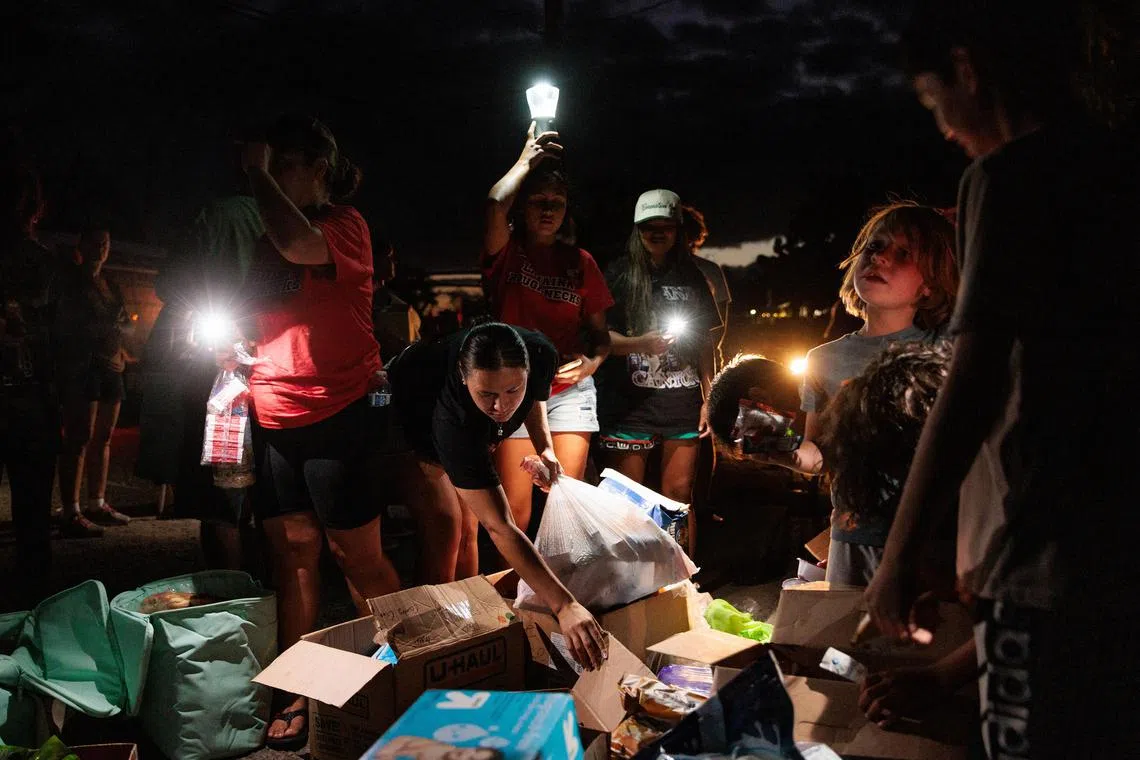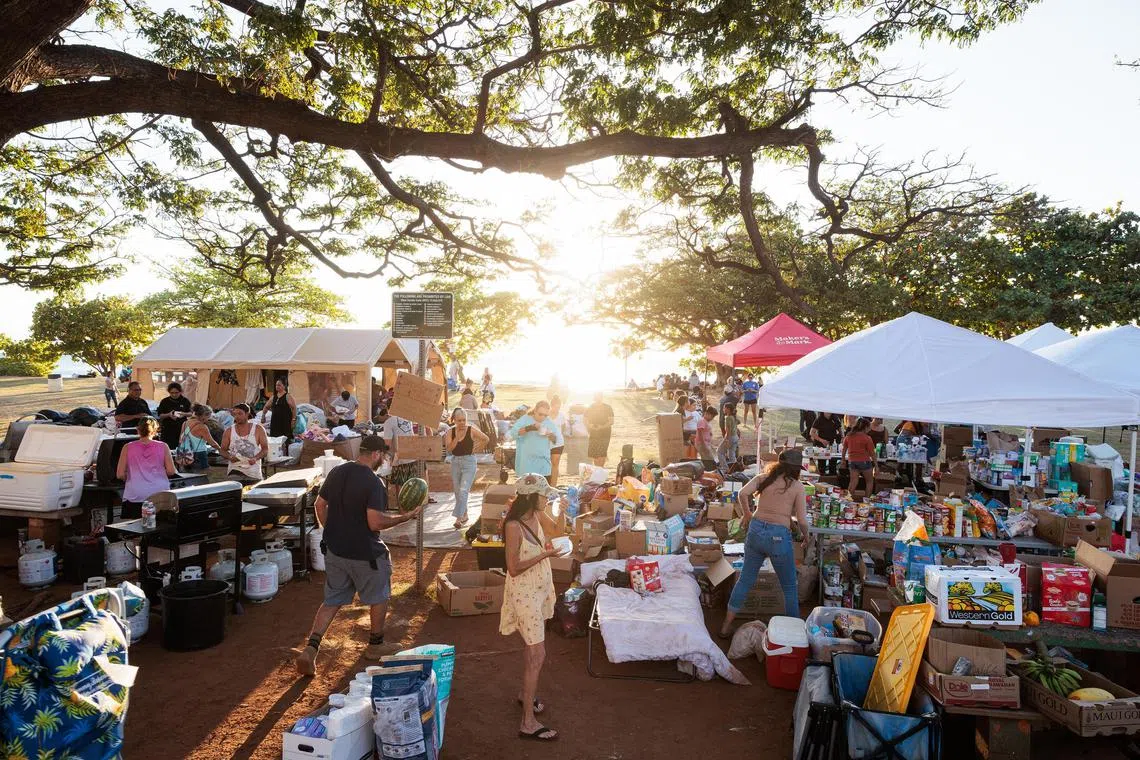‘We need some help here’: West Maui residents say government aid is scant
Sign up now: Get ST's newsletters delivered to your inbox

Residents collect food and other supplies delivered by volunteers in Olowalu, Maui, Hawaii, on Aug 12, 2023.
PHOTO: NYTIMES
Follow topic:
NAPILI-HONOKOWAI, Hawaii - Days after the deadliest United States wildfire in more than a century ignited in West Maui, killing dozens and levelling more than 2,200 buildings,
After the fire destroyed the Hawaiian town of Lahaina, hundreds of local residents – a group that includes evacuees along with nearby residents who found themselves cut off from power and Internet service – remained affected in West Maui, kilometres beyond the highway checkpoints. Some evacuees slept in parks, others remained in their own homes that survived the disaster or with friends in the wider community of that part of the island.
They have been searching desperately for fuel, phone reception and hot food, especially after power outages rendered refrigerators and microwaves useless. In many cases, they have leaned on church groups, community organisations and volunteers to track down missing relatives, get rides to shelters or access supplies brought in on private boats and airplanes.
“Where are the county officials? Nobody has Internet. I just found out you can’t drink the water,” said Mr Josh Masslon, who was sitting on a hill by the remote Kapalua Airport last Friday night trying to get cellphone service. “The communication has been nil.”
The death toll from the fire continued to rise – to at least 96 on Sunday – with more expected. While life in most other parts of Maui seems to have continued with little interruption, West Maui has felt like an island unto itself.
Residents and evacuees have been particularly desperate for fuel for their vehicles and generators. They have welcomed home-cooked meals from sympathetic residents elsewhere in Maui – the rice dishes and cans of Spam that are island favourites. Too little of it has been coming from government agencies, West Maui residents bemoaned.
“We need some help here,” Mr Rolando Advincula said as he loaded diapers for his nephews into the back of his car.
State, local and federal officials have had a presence in West Maui since the fires erupted last Tuesday. County firefighters confronted the inferno, Coast Guard sailors rescued people from the water and state officials have distributed supplies and organised temporary housing. Many West Maui residents relocated to government-run shelters in other parts of the island days ago.
Last Saturday, Hawaii Governor Josh Green, a Democrat, and Ms Deanne Criswell, the administrator of the Federal Emergency Management Agency, were among the officials from all levels of government who surveyed the destruction in Lahaina, a former capital of the Hawaiian kingdom, and pledged help for rebuilding.
Still, residents have complained that the official response has been remarkably lacking, describing the scattered fire warnings last Tuesday as insufficient, and the response since then as a failure that has not met their overwhelming, urgent needs.
Maui’s remoteness and the scale of the destruction – the fire in Lahaina surpassed the once-unfathomable Camp fire of 2018 in California as the deadliest in the US in more than a century – has made the response more challenging, officials said last Saturday. They promised that more help was on the way.
“We said, ‘If something ever happened here, we’re 72 hours away from help ever coming,’” said Chief John Pelletier of the Maui Police Department. “And I think we proved that that’s probably pretty accurate.”
He said the emergency response was far from complete, and that canine teams searching for cadavers began working on the island only last Saturday and had so far searched just about 3 per cent of the impacted area. Officials said they expect to find more bodies.
Of the people known to have died, the chief said that only two had been identified. He urged people searching for loved ones to take a DNA test that could help identify their remains.
“The remains we’re finding is through a fire that melted metal,” Mr Pelletier said. “We have to do rapid DNA to identify.”
As the search continued, people who stayed behind in West Maui said they have heard little directly from the government and did not know what forms of official aid were available.
“Nobody knows what’s going on out here,” said Mr Cord Cuniberti, who was taking supplies of Spam to a drop-off site with his friend. “We’re just relaying stuff – coconut wireless,” he said, using a local term meaning word-of-mouth and rumours.

A distribution centre for evacuees in Napili-Honokowai, Maui, Hawaii, on Aug 12, 2023.
PHOTO: NYTIMES
In Napili Park, north of Lahaina, locals set up one of many makeshift distribution centres under a canopy. They handed out canned goods, pallets of water, diapers and other supplies to those in need. People stretched out to rest on blankets in the shade as children played football and helped to unload boxes of goods.
Mr Paul Romero, who owns a gym in Kihei over 32km south-east of the hardest-hit area and led supply runs into West Maui, said he was heartened to see so many people rush to the aid of their neighbours up the coast.
But he echoed the concerns of many evacuees: They had not heard anything from the government, had received no aid other than from private volunteers and felt left in the dark.
“It’s an incredible dichotomy,” Mr Romero said last Saturday. “There is an outpouring of local support, boots on the ground, depleting our personal resources to support our Ohana in just the most basic ways,” he said, using a Hawaiian word for family.
“(But) the response from our well-funded, tax-paid government is incredibly pathetic. We can’t even understand what they did, what they didn’t do, what they’re still not doing.” NYTIMES

